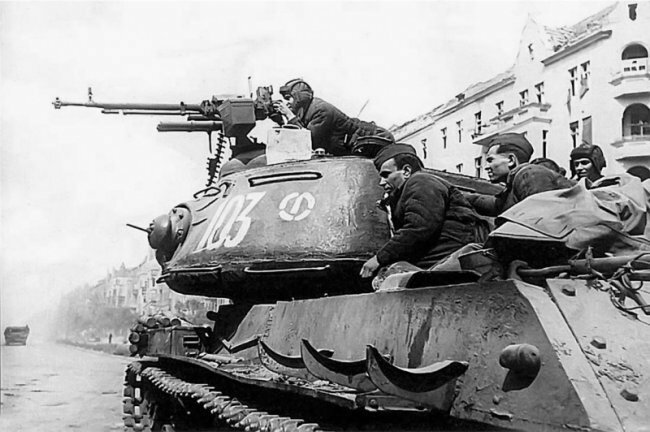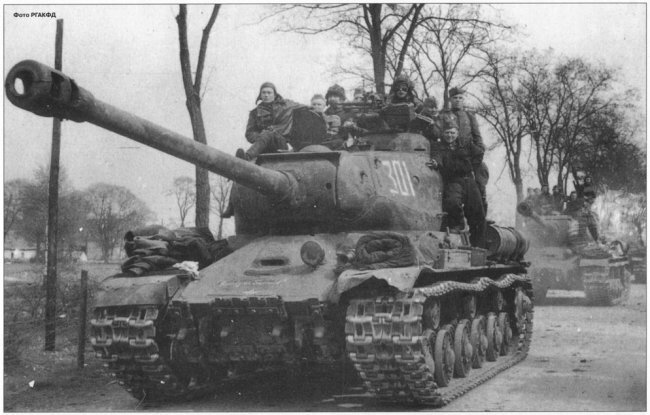IP v Tiger
Imagine the following situation: a duel between the Tiger and the IS-2 in ideal (flat terrain, distance up to 1000 m) and equal (quality of sights, level of training of gunners, full ammunition, gun with wedge bolt) conditions. At the same time, we will lay a 50% chance of being hit by the first shot and agree that both tank give a miss, but they must be hit by a second shell, which in real life often happened. What happens next?
The charging IC-2 takes an 25-kg projectile from the ammunition located in the aft niche of the turret and inserts it into the barrel, then sends it to the foreman with a sucker so that the leading belt is firmly wedged at the beginning of the rifling of the barrel. An experienced loader will send the projectile with his hand, which speeds up the process. Then the loader takes an 15-kg cartridge case with a charge from the right wall of the turret (we agreed that the ammunition unit is full, which means that after the first shot the turret still has one cartridge case with a charge, for the next one it’s necessary to dive down EC-2), puts it in the barrel and sends it. This closes the shutter automatically. The loader reports "Done", the tank commander says - "Fire", and the gunner, who during the loading time had time to correct the sight, presses the trigger and produces a shot. However, stop! Under all our conditions, the most trained loader will take all of the above to take at least 20 seconds, which means, no matter how sad it may be to admit, he will not have time to finish the loading process, because 8-mm will fly into the EC-2 tower in 88 seconds German projectile, and on the 16-th - the second! Thus, at the first miss, the “Tiger” with the rate of fire of its 6-8 cannons per minute did not leave the EC-2 any chance for a second shot. Even if our tanks were two, the Tiger, hitting the first EC-2, would have had time to give the first shot at the second on 4 a second before the response. In the end, it turns out that for the guaranteed defeat of one “Tiger” with the second shot, it is necessary to have three tanks EC-2.
Some data
Tank, gun Armor, mm / tilt, gr Armor piercing at a distance 1000 m, mm / gr Rate of fire, rds / min
EC-2, 122-mm D-25T frontal hull - 120 / 60 ° frontal towers - 150 / rounded 142 / 90 ° 2 ... 3
Tiger, 88-mm KwK 36 frontal hull - 100 / 8 ° frontal towers - 190 / 0 ° 100 / 60 ° 6 ... 8
From the above data, it follows that with 1000 m the Tiger could not penetrate either the forehead of the hull, or even more so the IP-2 towers. For this, he needed to come close at least on 500 ... 600 m. And it is also necessary to take into account that this is only true for the EC-2 of an early release, since after the introduction of a “straightened nose” on our tank (see M. Baryatinsky, EC-2, History creation), "KwK 36 tank gun L / 56 did not penetrate the frontal armor of the EC-2 when shooting from any distance."
For our own tank, the opposite is happening - with the 1000, he confidently punched the frontal armor of the Tiger's hull. If the projectile hit the front of the turret of the German tank without even punching it, the gap was guaranteed to damage the gun barrel and the Tiger remained unarmed.
So With 1000, Tiger could damage, but not destroy, EC-2. So the German tank makes the second shot - the 88-mm projectile damages the caterpillar. The third shot of the Tiger coincides with the second EC-2. German projectile knocks down the sight, X-NUMX-mm projectile EC-122 - breaks through the armor of the Tiger. German tank destroyed, Russian - damaged. And this is at the worst for our tank scenario.
Suppose another situation. The crew of the German tank knows that it needs to approach the EC-2 at a distance of 500 ... 600 m. With an average Tiger speed on the 25 terrain ... 30 km / h it will take about a minute for the 500 to cross. On the move, a German tank cannot shoot, because the lack of a gun stabilizer will reduce the probability of getting to zero. The EC-2, on the contrary, has time to make 3 shots.
Thus, with such a meeting face-to-face, Tigger was very unprofitable to join the battle.

German TanksTiger
The documentary film "German Tanks", as the name implies, tells about German tanks from the period of the Second World War; Perhaps, sometimes the comments behind the scenes of the presenter are not as adequate and historically correct, but the film is interesting to others, it consists entirely of film and photo chronicles.
This series of this documentary tells about stories the creation of the Tiger tank, its combat use, and also reveals in detail its tactical and technical characteristics (TTX).


Information